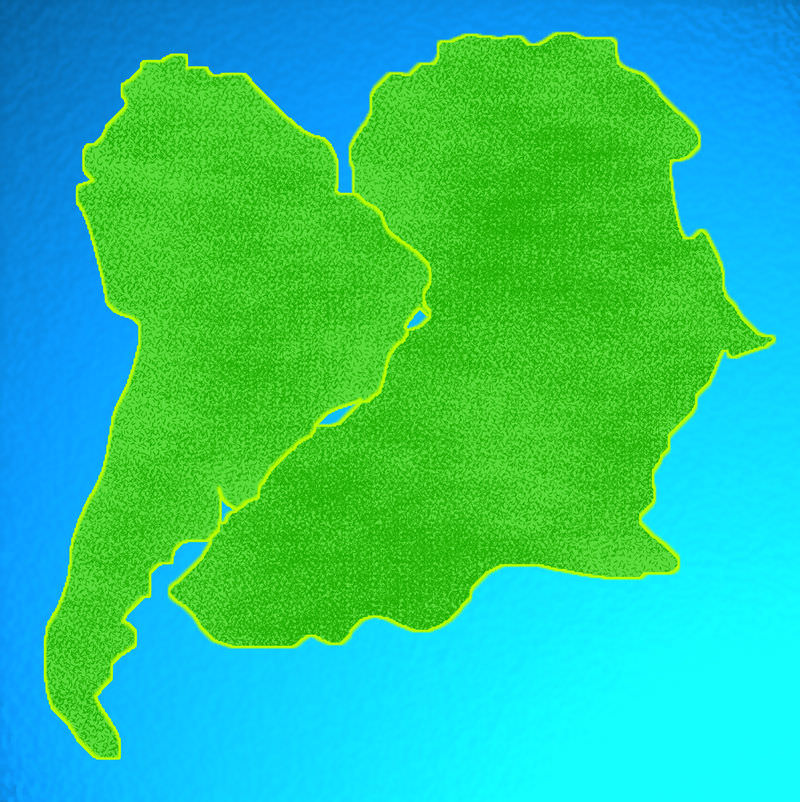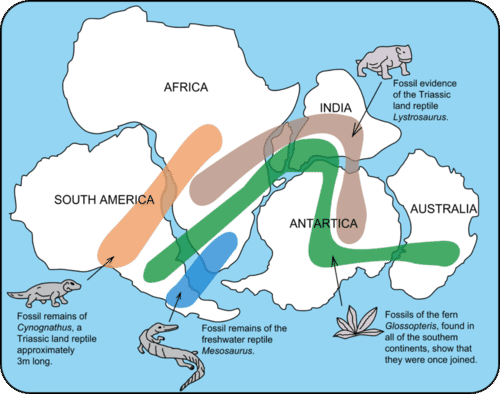5.1: Continental Drift
- Page ID
- 5379
\( \newcommand{\vecs}[1]{\overset { \scriptstyle \rightharpoonup} {\mathbf{#1}} } \)
\( \newcommand{\vecd}[1]{\overset{-\!-\!\rightharpoonup}{\vphantom{a}\smash {#1}}} \)
\( \newcommand{\dsum}{\displaystyle\sum\limits} \)
\( \newcommand{\dint}{\displaystyle\int\limits} \)
\( \newcommand{\dlim}{\displaystyle\lim\limits} \)
\( \newcommand{\id}{\mathrm{id}}\) \( \newcommand{\Span}{\mathrm{span}}\)
( \newcommand{\kernel}{\mathrm{null}\,}\) \( \newcommand{\range}{\mathrm{range}\,}\)
\( \newcommand{\RealPart}{\mathrm{Re}}\) \( \newcommand{\ImaginaryPart}{\mathrm{Im}}\)
\( \newcommand{\Argument}{\mathrm{Arg}}\) \( \newcommand{\norm}[1]{\| #1 \|}\)
\( \newcommand{\inner}[2]{\langle #1, #2 \rangle}\)
\( \newcommand{\Span}{\mathrm{span}}\)
\( \newcommand{\id}{\mathrm{id}}\)
\( \newcommand{\Span}{\mathrm{span}}\)
\( \newcommand{\kernel}{\mathrm{null}\,}\)
\( \newcommand{\range}{\mathrm{range}\,}\)
\( \newcommand{\RealPart}{\mathrm{Re}}\)
\( \newcommand{\ImaginaryPart}{\mathrm{Im}}\)
\( \newcommand{\Argument}{\mathrm{Arg}}\)
\( \newcommand{\norm}[1]{\| #1 \|}\)
\( \newcommand{\inner}[2]{\langle #1, #2 \rangle}\)
\( \newcommand{\Span}{\mathrm{span}}\) \( \newcommand{\AA}{\unicode[.8,0]{x212B}}\)
\( \newcommand{\vectorA}[1]{\vec{#1}} % arrow\)
\( \newcommand{\vectorAt}[1]{\vec{\text{#1}}} % arrow\)
\( \newcommand{\vectorB}[1]{\overset { \scriptstyle \rightharpoonup} {\mathbf{#1}} } \)
\( \newcommand{\vectorC}[1]{\textbf{#1}} \)
\( \newcommand{\vectorD}[1]{\overrightarrow{#1}} \)
\( \newcommand{\vectorDt}[1]{\overrightarrow{\text{#1}}} \)
\( \newcommand{\vectE}[1]{\overset{-\!-\!\rightharpoonup}{\vphantom{a}\smash{\mathbf {#1}}}} \)
\( \newcommand{\vecs}[1]{\overset { \scriptstyle \rightharpoonup} {\mathbf{#1}} } \)
\( \newcommand{\vecd}[1]{\overset{-\!-\!\rightharpoonup}{\vphantom{a}\smash {#1}}} \)
\(\newcommand{\avec}{\mathbf a}\) \(\newcommand{\bvec}{\mathbf b}\) \(\newcommand{\cvec}{\mathbf c}\) \(\newcommand{\dvec}{\mathbf d}\) \(\newcommand{\dtil}{\widetilde{\mathbf d}}\) \(\newcommand{\evec}{\mathbf e}\) \(\newcommand{\fvec}{\mathbf f}\) \(\newcommand{\nvec}{\mathbf n}\) \(\newcommand{\pvec}{\mathbf p}\) \(\newcommand{\qvec}{\mathbf q}\) \(\newcommand{\svec}{\mathbf s}\) \(\newcommand{\tvec}{\mathbf t}\) \(\newcommand{\uvec}{\mathbf u}\) \(\newcommand{\vvec}{\mathbf v}\) \(\newcommand{\wvec}{\mathbf w}\) \(\newcommand{\xvec}{\mathbf x}\) \(\newcommand{\yvec}{\mathbf y}\) \(\newcommand{\zvec}{\mathbf z}\) \(\newcommand{\rvec}{\mathbf r}\) \(\newcommand{\mvec}{\mathbf m}\) \(\newcommand{\zerovec}{\mathbf 0}\) \(\newcommand{\onevec}{\mathbf 1}\) \(\newcommand{\real}{\mathbb R}\) \(\newcommand{\twovec}[2]{\left[\begin{array}{r}#1 \\ #2 \end{array}\right]}\) \(\newcommand{\ctwovec}[2]{\left[\begin{array}{c}#1 \\ #2 \end{array}\right]}\) \(\newcommand{\threevec}[3]{\left[\begin{array}{r}#1 \\ #2 \\ #3 \end{array}\right]}\) \(\newcommand{\cthreevec}[3]{\left[\begin{array}{c}#1 \\ #2 \\ #3 \end{array}\right]}\) \(\newcommand{\fourvec}[4]{\left[\begin{array}{r}#1 \\ #2 \\ #3 \\ #4 \end{array}\right]}\) \(\newcommand{\cfourvec}[4]{\left[\begin{array}{c}#1 \\ #2 \\ #3 \\ #4 \end{array}\right]}\) \(\newcommand{\fivevec}[5]{\left[\begin{array}{r}#1 \\ #2 \\ #3 \\ #4 \\ #5 \\ \end{array}\right]}\) \(\newcommand{\cfivevec}[5]{\left[\begin{array}{c}#1 \\ #2 \\ #3 \\ #4 \\ #5 \\ \end{array}\right]}\) \(\newcommand{\mattwo}[4]{\left[\begin{array}{rr}#1 \amp #2 \\ #3 \amp #4 \\ \end{array}\right]}\) \(\newcommand{\laspan}[1]{\text{Span}\{#1\}}\) \(\newcommand{\bcal}{\cal B}\) \(\newcommand{\ccal}{\cal C}\) \(\newcommand{\scal}{\cal S}\) \(\newcommand{\wcal}{\cal W}\) \(\newcommand{\ecal}{\cal E}\) \(\newcommand{\coords}[2]{\left\{#1\right\}_{#2}}\) \(\newcommand{\gray}[1]{\color{gray}{#1}}\) \(\newcommand{\lgray}[1]{\color{lightgray}{#1}}\) \(\newcommand{\rank}{\operatorname{rank}}\) \(\newcommand{\row}{\text{Row}}\) \(\newcommand{\col}{\text{Col}}\) \(\renewcommand{\row}{\text{Row}}\) \(\newcommand{\nul}{\text{Nul}}\) \(\newcommand{\var}{\text{Var}}\) \(\newcommand{\corr}{\text{corr}}\) \(\newcommand{\len}[1]{\left|#1\right|}\) \(\newcommand{\bbar}{\overline{\bvec}}\) \(\newcommand{\bhat}{\widehat{\bvec}}\) \(\newcommand{\bperp}{\bvec^\perp}\) \(\newcommand{\xhat}{\widehat{\xvec}}\) \(\newcommand{\vhat}{\widehat{\vvec}}\) \(\newcommand{\uhat}{\widehat{\uvec}}\) \(\newcommand{\what}{\widehat{\wvec}}\) \(\newcommand{\Sighat}{\widehat{\Sigma}}\) \(\newcommand{\lt}{<}\) \(\newcommand{\gt}{>}\) \(\newcommand{\amp}{&}\) \(\definecolor{fillinmathshade}{gray}{0.9}\)What does a scientist do with an interesting observation?
Alfred Wegener made an observation. From that observation, he made a hypothesis. He collected evidence that would support or refute his hypothesis. What did that process look like?
Wegener’s Idea
Alfred Wegener, born in 1880, was a meteorologist and explorer. In 1910, he noticed that South America and Africa appeared to fit together like puzzle pieces. He was certainly not the first person to notice this. But he was intrigued by the idea and thought a lot about it. He wondered if the two continents were once joined and then moved apart? He set out to find evidence to support or refute this idea.
Wegener’s Evidence
Here is the main evidence that Wegener and his supporters collected for his continental drift hypothesis:
Fit of the Continents
The continents appear to fit together, and not just South America and Africa. If the continental margins are included, the fit is even better.
This figure shows the evolution of the continents, from the super-continent Pangaea to the way they look now.
Distribution of Fossils
Wegener found fossil evidence that the continents were once joined (Figure below). The same type of plant and animal fossils are found on continents that are now widely separated. These organisms would not have been able to travel across the oceans. So how did the fossils get so far apart?
Fossils of the seed fern Glossopteris are found across all of the southern continents. These seeds are too heavy to be carried across the ocean by wind. Mesosaurus fossils are found in South America and South Africa. Mesosaurus could swim, but only in fresh water. Cynognathus and Lystrosaurus were reptiles that lived on land. Both of these animals were unable to swim at all. Their fossils have been found across South America, Africa, India, and Antarctica.
Wegener thought that all of these organisms must have lived side by side. The lands later moved apart so that the fossils are separated.
Wegener used fossil evidence to support his continental drift hypothesis. The fossils of these organisms are found on lands that are now far apart. Wegener suggested that when the organisms were alive, the lands were joined and the organisms were living side-by-side.
Distribution of Rocks and Structures
Wegener found rocks of the same type and age on both sides of the Atlantic Ocean. He thought that it could not be a coincidence! He said that the rocks must have formed side by side. These rocks then drifted apart on separate continents.
Wegener also matched up mountain ranges across the Atlantic Ocean. The Appalachian Mountains were just like mountain ranges in eastern Greenland, Ireland, Great Britain, and Norway. Wegener concluded that they formed as a single mountain range. This mountain range broke apart as the continents split up. The mountain range separated as the continents drifted.
Climate Zones
Climate is found in zones around the planet. Warm tropical climates are mostly found near the Equator. Glaciers are mostly found nearer the poles. Wegener assumed that these things were true in the ancient past.
Glaciers
Wegener looked at evidence from ancient glaciers. Glaciers are found in very cold climates near the poles. The evidence left by some ancient glaciers is very close to the Equator. Did glaciers once exist near the equator? Wegener knew that this was extremely unlikely! However, if the continents had moved, the glaciers would have been centered close to the South Pole.
Tropics
Coral reefs are found only in warm water. Coal swamps are also found in tropical and subtropical environments. Wegener discovered ancient coal seams and coral reef fossils in areas that are much too cold today. Wegener thought that ancient coral and coal plants existed at about the same latitude where they are found today. He again stated that it was the continents that moved.
Summary
- Alfred Wegener made an observation. Africa and South America appeared to fit together like puzzle pieces.
- Wegener then asked an important question and set about to answer it. Were the continents once joined and then they drifted apart?
- Wegener collected a great deal of evidence to support his idea. Wegener’s evidence included the fit of the continents, the distribution of ancient fossils, the placement of similar rocks and structures on the opposite sides of oceans, and indicators of ancient climate found in locations where those climates do not exist today.
Review
- What was the scientific question that Wegener asked?
- What did he need to do to explore the question and make it into a hypothesis?
- What evidence did Wegener have to support his idea?
- Describe how Wegener used each type of evidence to support his idea.
Explore More
Use the resources below to answer the questions that follow.
- Who was Alfred Wegener?
- What evidence did Wegener find for Pangaea?
- What was the response to Wegener's hypothesis?
- What is the continental drift hypothesis?
- What do the continental plates consist of?
- What were formed when Pangaea broke apart?
- Is the word "theory" misused in these two videos? What is the better word?




